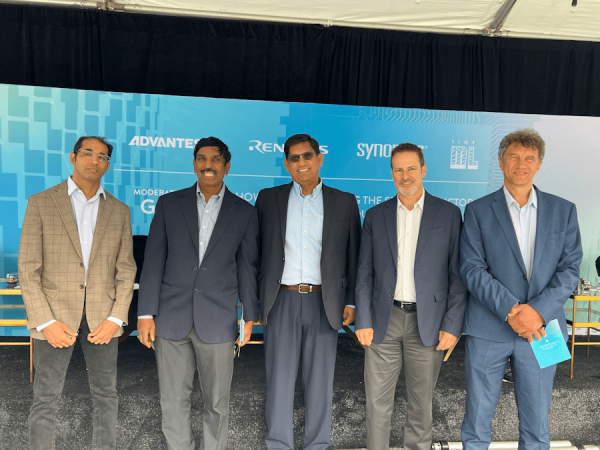Earlier this month, I had the pleasure of joining a group of industry peers during SEMICON West and the Design Automation Conference in San Francisco for an enlightening panel discussion that we organized titled, “How AI Is Reinventing the Semiconductor Industry Inside and Out.” Moderated by Gartner, I was joined on the panel by senior executives from Advantest, Synopsys, and the TinyML Foundation.
| Advantest | Ira Leventhal, US VP for Applied Research and Technology |
| Synopsys | Shankar Krishnamoorthy, GM of the EDA Group |
| TinyML Foundation | Evgeni Gousev, Chairman |
| Gartner | Gaurav Gupta, VP Analyst, Emerging Trends and Technologies |
For Renesas, artificial intelligence is becoming a game changer, particularly at the edge. In fact, despite all of the buzz circulating about generative AI and ChatGPT-4, about 75 percent of all of the data created by 2025 will come from the edge of the network – not the cloud. At the same time, 90 percent of data collected by enterprises gets discarded today, which opens an exciting opportunity to find productive uses for it.
Where does Renesas fit in? When we think of compute, we think of MCUs, MPUs, CPUs, and GPUs.
Innovative silicon architectures are key to processing data quickly, with low latency and low power. Renesas supplies a range of compute devices, from battery-powered MCUs to Linux-based MPUs. Intensive AI applications are offloaded to onboard accelerators with high TOPS/watt performance. For model deployment and management at scale and ML DevOps, Renesas also provides cloud connectivity stacks.
In addition to compute, Renesas also supplies memory interfaces, high-efficiency power, and timing silicon to our GPU customers and partners, all of which are key when it comes to processing huge amounts of data needed for large language models.
Welcoming the AI Productivity Train
Regardless of the specific focus, a successful AI outcome depends on how educated your customers are about their own data sets. If the customer requires a lot of hand-holding, we provide them with everything from the training models to implementation. On the other side are the customers who are extremely astute, in which case we work with more of a “freemium” model. And then there are customers that fall in between.
That said, across the enterprise, only 54 percent of projects that incorporate AI see the light of day. The reason the other 46 percent don’t is because of the challenges and complexities associated with deploying AI. Think about how much more productive we could be if we made the use case easy enough to grasp. That’s where things like TinyML come into play.
As Evgeni noted, “The TinyML ecosystem is a perfect radar screen, because we have over 100 member companies and 15,000 people working all over the world. Five years ago, this was a proof of concept, but five years from now we will see AI technology in the hands of consumers to help them solve all kinds of problems.”
Synopsys’ Shankar called out the role that AI will play in helping companies reduce design complexity and better manage engineering budgets, as the cost to move from a 5nm to a 3nm process node more than doubles. Shankar said Synopsys plans to optimize its customer IP by applying AI to every layer of the EDA stack, from design through verification and test, and already offers a software-as-a-service model that allows customers to access AI services in the cloud.
“We are seeing extremely fast adoption of AI technology, largely because our customers are seeing this productivity problem, and they are driving the adoption of AI as a priority,” he said. “We have over 250 production designs already completed, and that ramp has really shot up over the past 12 months. We have to solve the ‘making AI easier to adopt,’ problem as a tool vendor, but there is a hunger for it in the design community.”
In the realm of semiconductor test, Advantest must ensure that the equipment it builds is able to outperform the devices they’re testing. This includes using AI to test AI-based chips, which demands additional computing capabilities, and more recently, machine learning algorithms that help make immediate decisions across the entire semiconductor value chain.
“AI is driving our technology forward in a number of ways,” Ira said. “It used to be, as a test equipment vendor, we had to be faster and more accurate than the devices we’re testing. Now, with the advent of AI chips, we have to be smarter, too. That’s led us to use AI in a number of ways, including edge compute and machine learning algorithms we run in real-time during test. AI is going to be at the core of many things, and our engineers are going to have to embrace that and learn how to use it as a fundamental tool.”
We thank the panelists for their time and thoughtful contributions to this discussion. It’s clear that the conversation around AI is multi-faceted and evolving on a daily basis. Renesas is planning podcasts, webinars, and events to share with you the latest on fast-growing AI technology in the coming months. Stay tuned for more updates from us!
To learn more about Renesas’ AI portfolio and acquisition of Reality AI, please read our recent blog by Mohammed Dogar (June 29) and our Reality AI one year update press release (June 15).
Find information on products and technologies to help you implement AI solutions at renesas.com/AI.

